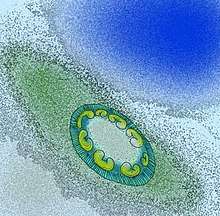Armillifera
Armillifera is an Ediacaran marine animal, that existed on Earth about 555 million years ago.[1] It was first described by the author Mikhail Fedonkin in 1980. Its fossils were discovered in the White Sea area, Arkhangelsk Region, Russia. The fossils of Armillifera were restricted to almost the same stratigraphic range as Kimberella, but was very rarely found.
| Armillifera | |
|---|---|
| Scientific classification | |
| Kingdom: | |
| Phylum: | |
| Genus: | Armillifera |
| Species: | A. parva Fedonkin, 1980 |
Morphology
Armillifera is bilaterally symmetric, oval shaped. It's convex in the center with a flattened surrounding band, and its surface is covered by numerous tubercles fused on the band to form rounded ridges. The surface of its central region possesses deep hook-shaped depressions, that are arranged accordingly to glide reflection symmetry.[2]

Classification
The 'shell' of Armillifera is lack of grow line, and the bilateral symmetry suggests that these are likely to be actively moving organisms.[2]
The fact that the deep hook-shaped depressions in its central region are arranged accordingly to glide reflection symmetry may refers its connection to Proarticulate, an extinct Ediacaran phylum that showed the same trace. But the resemblance of shell may not be the ultimate evidence, so it's still unclear which phylum did it belong to.
See also
References
- "Fossilworks: Armillifera". fossilworks.org. Retrieved 2018-12-06.
- Ivantsov, A. Yu (2010-12-01). "Paleontological evidence for the supposed precambrian occurrence of mollusks". Paleontological Journal. 44 (12): 1552–1559. doi:10.1134/S0031030110120105. ISSN 1555-6174.